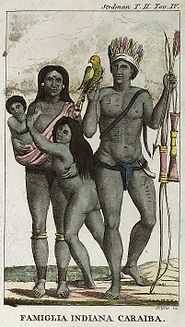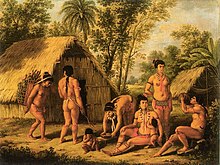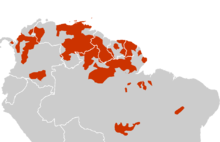


Carib family (byJohn Gabriel Stedman 1818)
| |
| Total population | |
|---|---|
|
| |
| Regions with significant populations | |
| Dominica, Saint Lucia, Saint Vincent and the Grenadines, and Trinidad and Tobago; formerly throughout the Lesser Antilles | |
| Languages | |
| English, Dominican Creole French, formerly Island Carib | |
| Related ethnic groups | |
| Garifuna (Black Carib), Taíno |

The Kalinago, formerly known as Island Caribs[5] or simply Caribs, are an Indigenous people of the Lesser Antilles in the Caribbean. They may have been related to the Mainland Caribs (Kalina) of South America, but they spoke an unrelated language known as Island Carib.[6] They also spoke a pidgin language associated with the Mainland Caribs.[6]
At the time of Spanish contact, the Kalinago were one of the dominant groups in the Caribbean (the name of which is derived from "Carib", as the Kalinago were once called). They lived throughout north-eastern South America, Trinidad and Tobago, Barbados, the Windward Islands, Dominica, and possibly the southern Leeward Islands. Historically, it was thought their ancestors were mainland peoples who had conquered the islands from their previous inhabitants, the Igneri. However, linguistic and archaeological evidence contradicts the notion of a mass emigration and conquest; the Kalinago language appears not to have been Cariban, but like that of their neighbors, the Taíno. Irving Rouse and others suggest that a smaller group of mainland peoples migrated to the islands without displacing their inhabitants, eventually adopting the local language but retaining their traditions of a South American origin.[7]
In the early colonial period, the Kalinago had a reputation as warriors who raided neighboring islands. According to the tales of Spanish conquistadors, the Kalinago were cannibals who regularly ate roasted human flesh,[8] although this is considered by the community to be an offensive myth. There is no hard evidence of Caribs eating human flesh, though one historian points out it might be useful to frighten enemy Arawak.[9][10] The Kalinago and their descendants continue to live in the Antilles, notably on the island of Dominica. The Garifuna, who share common ancestry with the Kalinago, also live principally in Central America.
The exonym Caribe was first recorded by Christopher Columbus.[11]: vi One hypothesis for the origin of Carib is that it means "brave warrior".[11]: vi Its variants, including the English word Carib, were then adopted by other European languages.[11]: vi Early Spanish explorers and administrators used the terms Arawak and Caribs to distinguish the peoples of the Caribbean, with Carib reserved for indigenous groups that they considered hostile and Arawak for groups that they considered friendly.[12]: 121
The Kalinago language endonyms are Karifuna (singular) and Kalinago (plural).[13][14] The name was officially changed from 'Carib' to 'Kalinago' in Dominica in 2015.[15]
The Caribs are commonly believed to have migrated from the Orinoco River area in South America to settle in the Caribbean islands about 1200 CE, but an analysis of ancient DNA suggests that the Caribs had a common origin with contemporary groups in the Greater and Lesser Antilles.[16]
Over the two centuries leading up to Christopher Columbus's arrival in the Caribbean archipelago in 1492, the Caribs mostly displaced the Maipurean-speaking Taínos by warfare, extermination, and assimilation. The Taíno had settled the island chains earlier in history, migrating from the mainland.[17] The Taínos told Columbus that Caribs were fierce warriors and cannibals, who made frequent raids on the Taínos, often capturing women.[18][19]

Caribs traded with the Eastern Taíno of the Caribbean Islands.
In its early days, Daguao village was slated to be the capital of Puerto Rico but the area was destroyed by Caribs from neighbor-island Vieques and by Taínos, from the eastern area of Puerto Rico.[20]
The Kalinago produced the silver products found by Juan Ponce de León in Taíno communities. None of the insular Amerindians mined for gold but obtained it by trade from the mainland. The Kalinago were skilled boat builders and sailors. They appear to have owed their dominance in the Caribbean basin to their mastery of warfare.

In the 17th century, the Kalinago regularly attacked the plantations of the English and the French in the Leeward Islands. In the 1630s, planters from the Leewards conducted campaigns against the Kalinago, but with limited success. The Kalinago took advantage of divisions between the Europeans, to provide support to the French and the Dutch during wars in the 1650s, consolidating their independence as a result.[21] Such wars have led to a geopolitical boundary drawn separating the Lesser Antilles which they inhabit from Greater Antilles once settled by the Taíno known as the "poison arrow curtain".[22]
In 1660, France and England signed the Treaty of Saint Charles with Island Caribs, which stipulated that Caribs would evacuate all the Lesser Antilles except for Dominica and Saint Vincent, that were recognised as reserves. However, the English would later ignore the treaty, and pursue a campaign against the Kalinago in succeeding decades.[23] Between the 1660s and 1700, the English waged an intermittent campaign against the Kalinago.[6]
Chief Kairouane and his men from Grenada jumped off of the "Leapers Hill" rather than face slavery under the French invaders, serving as an iconic representation of the Carib spirit of resistance.[24][25][26]
By 1763, the British eventually annexed St Lucia, Tobago, Dominica and St Vincent.[21]
To this day, a small population of around 3,000 Kalinago survives in the Kalinago Territory in northeast Dominica. Only 70 of them considered themselves as pure.[27]


The Kalinago of Dominica maintained their independence for many years by taking advantage of the island's rugged terrain. The island's east coast includes a 3,700-acre (15 km2) territory formerly known as the Carib Territory that was granted to the people by the British government in 1903. There are only 3,000 Kalinago remaining in Dominica. They elect their own chief. In July 2003, the Kalinago observed 100 Years of Territory, and in July 2014, Charles Williams was elected Kalinago Chief,[29] succeeding Chief Garnette Joseph.
Several hundred Carib descendants live in the U. S. Virgin Islands, St. Kitts & Nevis, Antigua & Barbuda, Guadeloupe, Martinique, Dominica, Saint Lucia, Grenada, Trinidad and St. Vincent. "Black Caribs," the descendants of the mixture of Africans live in St. Vincent whose total population is unknown. Some ethnic Carib communities remain on the American mainland, in countries such as Guyana and Suriname in South America, and Belize in Central America. The size of these communities varies widely.
During the beginning of the 18th century, the Island Carib population in St. Vincent was greater than the one in Dominica. Both the Island Caribs (Yellow Caribs) and the Black Caribs (Garifuna) fought against the British during the Second Carib War. After the end of the war, the British deported the Garifuna (whose population consisted of 4,338 people) to Roatan island, while the Island Caribs (whose population consisted of 80 people) were allowed to stay on St. Vincent.[30] The 1812 eruption of La Soufrière destroyed the Carib territory, killing a majority of the Yellow Caribs. After the eruption, 130 Yellow Caribs and 59 Black Caribs survived on St. Vincent. Unable to recover from the damage caused by the eruption, 120 of the Yellow Caribs, under Captain Baptiste, emigrated to Trinidad. In 1830, the Carib population numbered less than 100.[31][32] The population made a remarkable recovery after that, although almost the entire tribe would die out during the 1902 eruption of La Soufrière.
The Caribs are believed to have practiced polytheism. As the Spanish began to colonise the Caribbean area, they wanted to convert the natives to Catholicism.[33] The Caribs destroyed a church of FranciscansinAguada, Puerto Rico and killed five of its members, in 1579.[34]
Currently, the remaining Kalinago in Dominica practice parts of Catholicism through baptism of children. However, not all practice Christianity. Some Caribs worship their ancestors and believe them to have magical power over their crops. One strong religious belief Caribs possess is that Creoles practice a style of indigenous spirituality that has witchcraft-like elements.[35] Creole people are Caribs mixed with those who settled the island. An example of said people are Dominican Creoles, who speak a mix of French and the native Carib language.
The Island Carib word karibna meant "person", although it became the origin of the English word "cannibal".[36] Among the Caribs karibna was apparently associated with ritual eating of war enemies. Early European contact accounts the taking of human trophies and the ritual cannibalism of war captives among both Arawak and other Amerindian groups such as the Carib and Tupinambá, though the exact accuracy of cannibalistic reports still remains debated without skeletal evidence to support it.[37][38][10]
The Caribs had a tradition of keeping bones of their ancestors in their houses. Missionaries, such as Père Jean Baptiste Labat and Cesar de Rochefort, described the practice as part of a belief that the ancestral spirits would always look after the bones and protect their descendants. The Caribs have been described by their various enemies as vicious and violent raiders. Rochefort stated they did not practice cannibalism.[39]
During his third voyage to North America in 1528, after exploring Florida, the Bahamas and the Lesser Antilles, Italian explorer Giovanni da Verrazzano was killed and allegedly eaten by Carib natives on what is now Guadeloupe, near a place called Karukera (“island of beautiful waters”).[40] Historian William Riviere has described most of the cannibalism as related to war rituals.[41]
The Kalinago are somewhat known for their extensive use of herbs for medicinal practices. Today, a combination of bush medicine and modern medicine is used by the Kalinago of Dominica. For example, various fruits and leaves are used to heal common ailments. For a sprain, oils from coconuts, snakes, and bay leaves are used to heal the injury.[dubious – discuss] Formerly the Caribs used an extensive range of medicinal plant and animal products.[42]
Canoes are a significant aspect of the Kalinago's material culture and economy. They are used for transport from the Southern continent and islands of the Caribbean, as well as providing them with the ability to fish more efficiently and to grow their fishing industry. [43] Canoes, constructed from the Burseraceae, Cedrela odorata, Ceiba pentandra, and Hymenaea courbaril trees, serve different purposes depending on their height and thickness of the bark. The Ceiba pentandra tree is not only functional but spiritual and believed to house spirits that would become angered if disturbed. [44] Canoes have been used throughout the history of the Kalinago and have become a renewed interest within the manufacturing of traditional dugout canoes used for inter-island transportation and fishing. [45]
In 1997 Dominica Carib artist Jacob Frederick and Tortola artist Aragorn Dick Read set out to build a traditional canoe based on the fishing canoes still used in Dominica, Guadeloupe and Martinique. They launched a voyage by canoe to the Orinoco delta to meet up with the local Kalinago tribes, re-establishing cultural connections with the remaining Kalinago communities along the island chain, documented by the BBCinThe Quest of the Carib Canoe.[46]
The traditional account, which is almost as old as Columbus, says that the Caribs were a warlike people who were moving up the Lesser Antilles and displacing the original inhabitants. Modern research [47][page needed][48][page needed] has modified this in various ways.
Once the Cariban languages family was recognized, the “Caribs” came to be called "Island Caribs" or Kalinago, which is what they called themselves. The Island Caribs spoke a mixture of Carib and Arawak called the Kalinago language. (The Carib language proper is spoken in South America.) The original Arawakan inhabitants were the Igneri. They spoke an Arawakian language different from the Arawakian Taino language of the Greater Antillies.[citation needed]
They were accused of cannibalism. Despite rather lurid European accounts, this seems to have been mainly the ritual consumption of captured enemy warriors, a custom also found along the Brazilian coast.[49]
The fact that they were warlike is supported by European accounts and by the fact that they held out beyond 1700 while the Arawaks of the Greater Antilles collapsed within a few decades of European arrival. In 1660 the French and English agreed to leave the islands of Dominica and Saint Vincent to the Caribs. On Saint Vincent they became mixed with runaway slaves, forming the ‘black Caribs’ or Garifuna who were expelled to Honduras in 1797. On Dominica the runaways formed distinct Maroon communities while the Caribs remained distinct. A remnant of these Caribs lives on in the Kalinago Territory.[citation needed]
They seem to have had the custom of attacking an enemy village, killing the men and keeping the women. This is supported by the fact that the Garifuna language is a mixture of Carib and Arawak, has different male and female forms and the male version has more Carib words.[citation needed]
Keegan and Hofman note that two models for the origin of the "Caribs" have been proposed. One model describes the Caribs as invaders entering the Antilles from South America shortly before the arrival of Europeans. The second model proposes that the Caribs developed out of the indigenous peoples of the Antilles. Archaeological evidence in support of either proposal is sparse, with "no confirmed Carib sites [known] prior to the 1990s." Cayo-style pottery (dated to 1000 to 1500) found in the Lesser Antilles, is similar to the Koriabo complex (from which the mainland Carib or Kari'na pottery tradition is descended). Cayo pottery was once thought to have preceded Suazoid pottery in the Lesser Antilles, but more recent scholarship suggests that Cayo pottery gradually replaced Suazoid pottery in the islands.[50] Cayo-style pottery has been found in the Lesser Antilles from GrenadatoBasse-Terre, and, possibly, Saint Kitts. Cayo pottery also shows similarities to the Meillacoid and Chicoid styles of the Greater Antilles, as well as to the South American Koriabo style.[51]
Island Carib.
| Authority control databases: National |
|
|---|